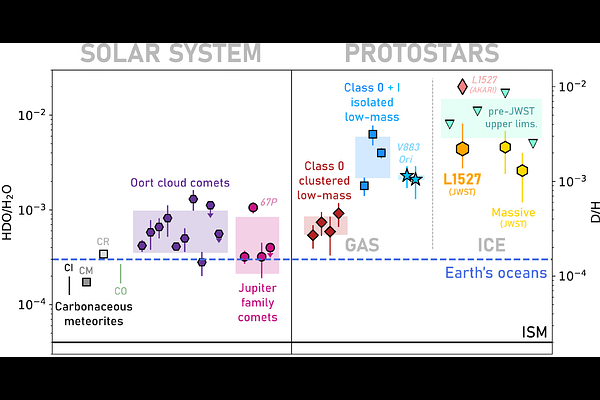HDO ice detected toward an isolated low-mass protostar with JWST

HDO ice detected toward an isolated low-mass protostar with JWST
Katerina Slavicinska, Łukasz Tychoniec, María Gabriela Navarro, Ewine F. van Dishoeck, John J. Tobin, Martijn L. van Gelder, Yuan Chen, A. C. Adwin Boogert, Blake Drechsler, Henrik Beuther, Alessio Caratti o Garatti, S. Thomas Megeath, Pamela Klaassen, Leslie W. Looney, Patrick J. Kavanagh, Nashanty G. C. Brunken, Patrick Sheehan, William J. Fischer
AbstractWater is detected in environments representing every stage of star and solar system formation, but its chemical evolution throughout these stages remains poorly constrained. Deuterium ratios offer a means of probing chemical links between water in different cosmic regions because of their sensitivity to physicochemical conditions. Here, we present the first detection of the 4.1 $\mu$m HDO ice feature with JWST toward L1527 IRS, an isolated low-mass protostar that may eventually grow to a sun-like mass. We measure an ice HDO/H$_{2}$O ratio of 4.4$^{+3.7}_{-1.7}$$\times$10$^{-3}$, where the reported error is dominated by uncertainties in continuum definition and ice band strengths. This fraction is similar to the gas HDO/H$_{2}$O ratios measured in the warm ($>$100 K) inner cores of other low-mass protostellar envelopes and protoplanetary disks found in comparably isolated star-forming regions. Such a similarity tentatively supports the assumption that water vapor detected in these regions is not significantly altered by gas-phase reactions following ice sublimation. It also supports the hypothesis that pre- and protostellar water ice is largely inherited in a chemically unaltered state by outer protoplanetary disks. However, the fraction is a factor of $\sim$4-10 times higher than the gas HDO/H$_{2}$O ratios measured toward comets and low-mass protostars in clustered star-forming regions. This difference may be due to either gas-phase water reprocessing in protostellar envelopes and protoplanetary disks, or differences between prestellar conditions of isolated dense cores and the clustered star-forming regions that are more analogous to the environment in which our Sun formed.